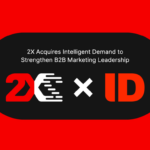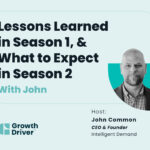
Revenue Leaders: Randy Frisch, CMO at Uberflip
Marketing is changing. It is evolving, it is transforming, and its practitioners are putting new technology and methodologies to work every single day to drive pipeline and hit revenue numbers. What we find particularly exciting about the evolution of the Modern Marketer is that Marketing and Sales are working together in ways that they never have before. There is a renewed faith in Marketing’s ability to drive revenue thanks to an abundance of new MarTech and business intelligence (BI) tools, change agents who are transforming marketing operations from the inside, and the emergence of Revenue Leaders who have become influencers, authors, podcast hosts, and highly sought-after speakers.
One of our favorite Revenue Leaders is Randy Frisch, CMO at Uberflip – because he ticks almost every box above. He is a best-selling author and change agent, leading the content experience movement that is transforming the way marketers across the world approach content strategy. He is a compelling speaker and an industry influencer, with thousands of followers preaching his gospel: “f#ck content marketing”.
So, with a resume like that, we couldn’t wait to see how Randy would do in our Revenue Leaders hot seat. We asked him some of the questions our clients and B2B companies across the world frequently ask us about content experience and Account Based strategy.
Here is what he had to say:
Who do I need on my team to make ABM work? More specifically, who do I need on my team to make my content strategy work? And by work we mean drive pipeline.
Randy: That’s a great question. In fact, I think a lot of the problems with both content and ABM are sometimes the same, which is that we define these terms at the early stages of each of their respective processes. With ABM, we talk a lot about finding the right accounts and tiering the right accounts, but what we ignore is ‘how are we going to engage those accounts?’ Content marketing or content strategy is sometimes the same, where we think about content and we think about who’s going to create the content or who’s going to be the editorial director on that content, rather than also looking at who’s actually going to leverage all that content.
So, we start to think of both of these for driving pipeline. It’s about the activation of that content. The other term that’s often thrown around there is how do people experience your content?
Hence the big trend these days of content experience. I’m really excited to see that there are now people taking on the job title of Content Experience [insert title here]. Now, your company may not be ready to do this yet, but that only means that it falls on a combination of demand gen, ABM, and digital marketers to work together with the content team to ensure that all that the content being created is actually being used in the campaigns to keep people engaged.
What role does content play in a successful ABM strategy?
Randy: Well, I can’t take credit for this, but Laura Ramos over at Forrester talks a lot about thinking about what happens after we tier those accounts. She talks about it in one of the papers she wrote around Account Based Engagement and that’s where content really comes into play. Laura talks about the idea of choreographing the dance steps of your customers’ audience – and I love that idea. It’s the reality of where we are today, which is that we don’t all go down one single path. We don’t come to your website and say, “I’ll read this post and then I’ll read that post.” If it was that easy, we would just have seven pieces of content on one page that’s going to appeal to everyone. The part that we have to do is to pick the right content to put in front of different people.
To do this, I often go back to thinking about the definition of content experience. And the definition of content experience comes down to the environment that we set, the structure, and the engagement. And as long as we take those into play with our content: we set up a great environment, make sure that content looks good, it looks compelling so that people are intrigued to read it, we structure it in a way that’s appealing to the account that we’re going after… then ultimately, we can start to do things to get them to engage, to get them through that buyer journey.
How has content experience different than what we’ve already been doing in content marketing?
Randy: Well, I’m definitely passionate about this one seeing that I wrote a book on it and I apologize for dropping an f bomb even on paper, but the book is called F#ck Content Marketing. To clarify, my point was not that we should stop content marketing. In fact, a lot of my team wanted that to be the title of the original blog posts that led to the book, but I clarified with them that we need content. We in fact often undervalued the content marketers and content creators inside of our organization, and that’s also the problem. We define content marketing purely as creation of content, not associating how we map that content throughout the buyer journey.
Content experiences, as I answered above, really looks at a combination of that environment, structure, and engagement that we put a lot of effort around to ensure that people will read the content. The more we focus on that, the more content they’ll consume, and as long as that content is great, then we can start to ensure that people stick with us to learn more.
Gartner says 82% of the entire buyer cycle, not just the point in which they’re ready to buy, but the entire buyer cycle is spent doing research. That is content. The other 18% that we do will be spent talking to your Sales reps.
I’ve bought into content experience and investing in content as part of my company’s ABM strategy. How do I get started and how do I scale?
Randy: I’m glad you asked this. The reality is, most of us make a crucial mistake when we say we’re ready to do content experience, which is we simply say, “we’ve got a lot of content, let’s just start putting it in front of people”. The part that breaks is our ability to scale. ABM is a very different strategy than a lot of the tactics we’ve historically taken with inbound. Inbound is usually more of that one-to-many approach that we associate with ABM, where we think about different categories and interests of our audience. But true ABM starts to get very personal and looks at the needs and problems that people have. To do that, we need a framework that allows us to put the right content in front of any account.
Take as an example a company we work with called Snowflake.
They have gotten to the point where they created dedicated pages of content (which they call content streams) for over 1200 target accounts that they as a company want to land. To do that, they’ve adopted the content experience framework. The content experience framework is a simple five step process:
Step 1: how to centralize your content
Step 2: how to organize
Step 3: how to personalize
Step 4: how to distribute, and
Step 5: how to generate results
When we do this, we start to become able to accomplish scale. If you want to check out more about that framework, simply go to uberflip.com/ce.
How do I build synergy between my internal teams to encourage a cohesive approach toward ABM?
Randy: Well, the first question is what internal teams are you referring to here? The first thing is to ensure that your Marketing team is aligned. Too often we’ll see that within Marketing teams, we’re not all aligned on ‘what did we do, as we spoke about earlier, to engage these accounts?’. We spent so much time thinking about and choosing the accounts, and we have so many other individuals within our Marketing org who are creating content, etc… who don’t know how to fuel that back. So, ensuring that there’s a buyer journey that is understood and adopted by your whole Marketing team is key.
The second step is ensuring that Marketing and Sales are aligned. Now, Marketing and Sales alignment is not easily done, but it starts with ensuring that you map in clever ways between those two departments. As an example, a company I spoke to recently has set up an individual Marketing Manager who is matrixing back to an area VP of Sales. So, each area VP has a respective marketer who’s taking the time to ensure that the content being put together for different accounts aligns properly. Depending on the size of your organization, you may have one marketer doing this or you may have many marketers doing this. There’s also different structures to approach this and to map properly in this way, but the key is to ensure that you start with great communication.
I’m a modern marketer who wants to move from content marketing to content experience? What’s the first thing I should do?
Randy: This is actually a funny question. The reality is we don’t start doing content experience. We could start to put more of a focus to content experience, but we have to realize that all of us are delivering a content experience. There’s a funny example I often use, which is the line, “if a tree falls in the forest and no one’s around does it make a noise?” We all know that one and we can all debate it, but in my opinion, it definitely makes a noise. The same thing can be said about content experience. If we don’t put a focus on content experience, we’re still delivering one.
Content experience is simply what your audience feels when they encounter your content. Are they compelled to engage or not?
So, if we don’t put a focus on content experience, at the end of the day, we’re still delivering one.
To answer your question properly in terms of how do we make that move, I think it starts with having the right people in charge. This isn’t always a technology problem and a lot of us jump to say, “we need tech to solve this.” Well, at some point you may need tech to solve it. That’s where companies like Uberflip come in, but you need to make sure that you have the right ownership over content experience. We’ve seen, as I said above, that some companies are actually adopting Content Experience Managers into their organization, but ensuring that content experience is something that everyone on your team is focused on is a great start.
What are the ABM reporting must haves, especially when it comes to measuring the ROI of my content strategy?
Randy: The key here is ensuring that we could track the engagement of content so that we can understand what attribution is being put back to that content. We can do this through our marketing automation platform, but we need to ensure that the content experience we serve has the functionality to deliver those insights back.
Ideally, we get to the point where not only can we deliver those insights back, but we can alter the content experience based on those trackings. Using solutions like Uberflip allows this – we are ensuring to track that engagement through, in our case Marketo, and through Bizible so we can visualize that. We’re also using data through other sources like Bombora to adjust what content is served on the fly.
That’s when we start to get to the point where we’re using insights to drive our content strategy.
How do I prove content ROI?
Randy: The key here is quite simple. It’s: is your content helping you win deals or lose deals?
What we can do is start to see where there’s a drop-off in content engagement. If someone clicks on a piece of content, that may not be something that we should celebrate. The celebration is that that content took them to another piece, which the took them to an eventual conversion; either becoming a task for a demo to learn more about your product or deeper in the funnel to do things that may even involve making that final decision to purchase. The key to that is our ability to track engagement. At Uberflip, we use a combination of systems to do this. We use Marketo, we use Bizible, and we also use Uberflip, which provides a lot of data for us to understand how content is being consumed by who and at what stages. We’ll also leverage our, our Business Intelligence team, using a platform called Domo to help visualize that path for specific accounts so we can see core pieces of content, and core stages of that funnel that led to ultimately purchase.
How can Uberflip help my company succeed with ABM?
Randy: Having content doesn’t mean that people are going to buy from you. A lot of us assume that just because we’re creating that content that people, in turn, will use that content to make their decisions. Too many of us expect our accounts to go sifting through our website to find the content that they’re looking for. These days, our audiences are living in an on-demand world. That’s the case with Netflix. That’s the case with Spotify. That’s even the case with Amazon. Their expectation is that we will be able to serve content to them in that same on-demand fashion. Going to the website and sorting through it as we said does not mirror that Netflix experience. The key is for your account to feel like they understand what’s important to you. Now, part of that is choosing the right content to put him in front of them and having a system that will allow you to do that at scale.
I gave the example earlier of Snowflake who’s now doing this for over 1200 accounts. When they started with this approach, they didn’t yet have technology and they were able to do it for 10 or 12 accounts manually. Ultimately, they got to a point where for scale they needed technology. That’s where the combination of great people on your team, a great process, like the content experience framework, and ultimately, technology at the right time will allow you to scale your ABM and engage with more of your accounts to keep them moving through the buyer journey.



